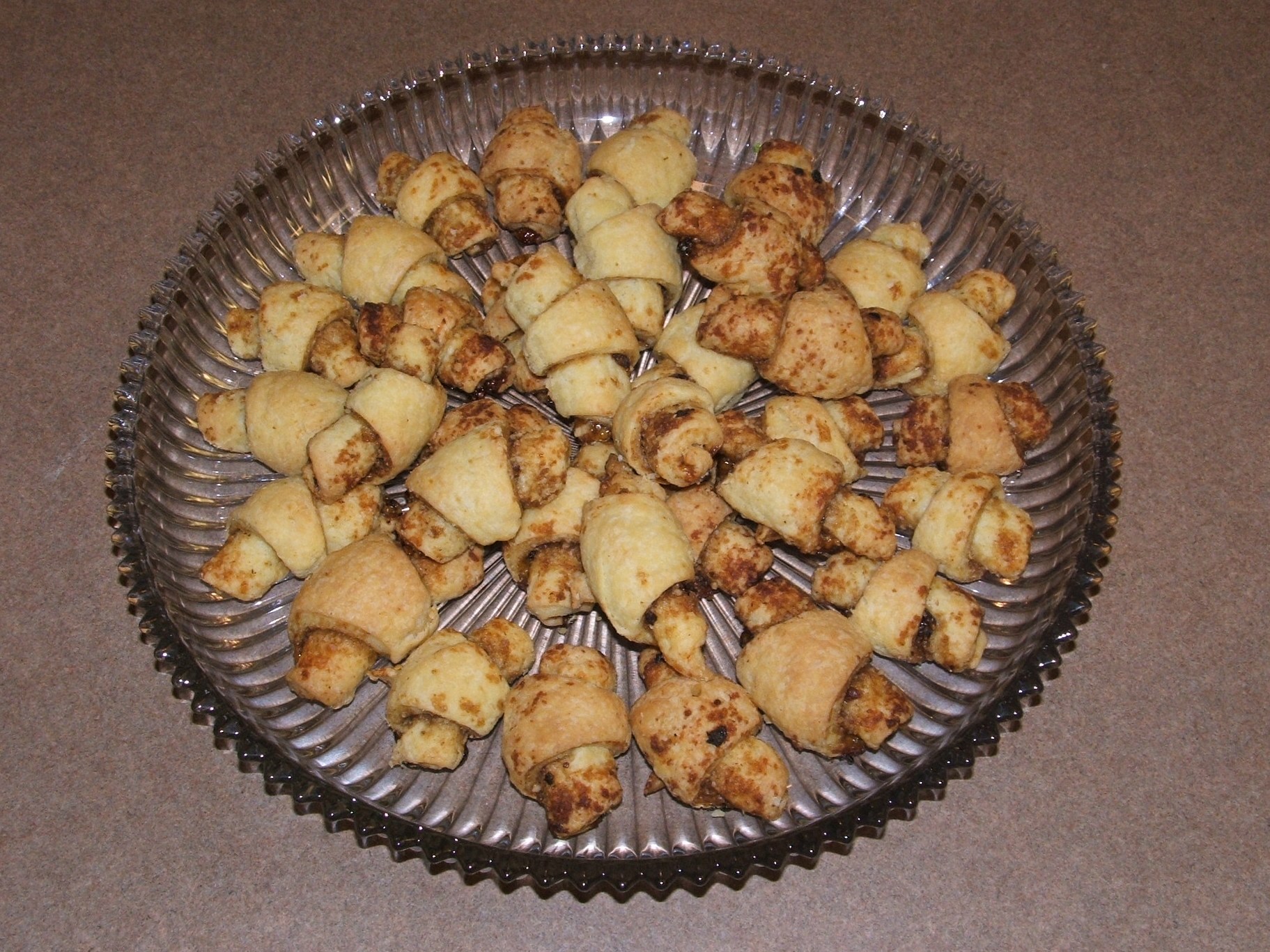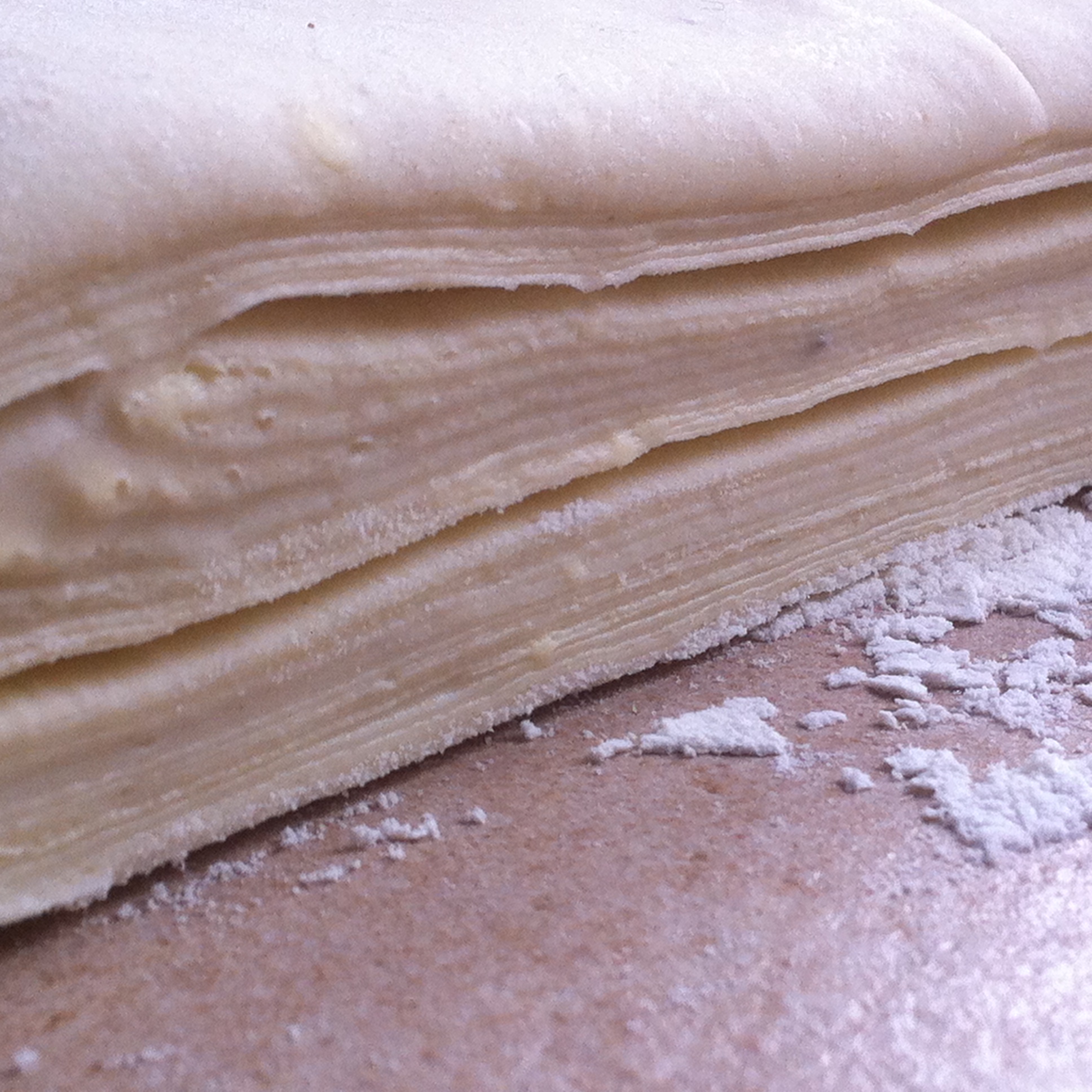|
Croissant
A croissant is a buttery, flaky, Austrian viennoiserie pastry inspired by the shape of the Austrian kipferl but using the French yeast-leavened laminated dough. Croissants are named for their historical crescent shape, the dough is layered with butter, rolled and folded several times in succession, then rolled into a thin sheet, in a technique called laminating. The process results in a layered, flaky texture, similar to a puff pastry. Crescent-shaped breads have been made since the Renaissance, and crescent-shaped cakes possibly since antiquity but using brioche dough. Kipferls have long been a staple of Austrian, and French bakeries and pâtisseries. The modern croissant was developed in the early 20th century when French bakers replaced the brioche dough of the kipferl with a yeast-leavened laminated dough. In the late 1970s, the development of factory-made, frozen, preformed but unbaked dough made them into a fast food that could be freshly baked by unskilled labor ... [...More Info...] [...Related Items...] OR: [Wikipedia] [Google] [Baidu] |
Pain Au Chocolat
Pain au chocolat (, literally "chocolate bread"), also known as chocolatine () in the south-west part of France and in Canada, or couque au chocolat in Belgium, is a type of Viennoiserie pastry consisting of a cuboid-shaped piece of yeast- leavened laminated dough, similar in texture to a puff pastry, with one or two pieces of dark chocolate in the center. Pain au chocolat is made of the same layered doughs as a croissant. Often sold still hot or warm from the oven, they are commonly sold alongside croissants in French bakeries and supermarkets. Name In France, the name of the pain au chocolat varies by region: *In the Hauts-de-France and in Alsace, the words or are used. *In central France, in southern France and in Paris, is used. *In southwestern France ( Nouvelle-Aquitaine, Occitanie) and in Canada, the word is used. In Belgium, the words are also used. They are often sold in packages at supermarkets and convenience stores, or made fresh in pastry shops ... [...More Info...] [...Related Items...] OR: [Wikipedia] [Google] [Baidu] |
Kifli
Kifli, kiflice, kifle or kipferl is a traditional yeast bread roll that is rolled and formed into a crescent before baking. It is a common type of bread roll throughout much of central Europe and nearby countries, where it is called by different names. It is thought to be the inspiration for the French croissant, which has a very similar shape but is made with a different type of dough. Names The breadstuff or pastry is called: *''kifli'' in Hungarian *''kipfl'' in Austrian Italy *''Kipferl'' in Austrian German **''küpfel'' or a Meidlinger roll in Vienna *''kifla'' or ''кифла'' (pl. ''kifle'' or ''kiflice'') in Croatian, Bosnian, and Serbian *''кифла'' or kifla in Bulgarian *''кифла'' in Macedonian *''kifle'' in Albanian *''giffel'' in Danish and Swedish *''gipfel'' in Switzerland *''rogal'' or ''rogalik'' (little horn) in Polish *''rohlík'' in Czech *''rožok'' in Slovak *рогалик/''rogalik'' in Russian *рогалик/''rohalyk'' in Ukrain ... [...More Info...] [...Related Items...] OR: [Wikipedia] [Google] [Baidu] |
Continental Breakfast
Breakfast, the first meal of the day eaten after waking from the night's sleep, varies in composition and tradition across the world. Africa Breakfast in Africa varies greatly from region to region. Algeria Breakfast in Algeria is heavily influenced by French colonialism and most commonly consists of café au lait or espresso along with a sweet pastry (some common examples are croissants, mille-feuilles, pain au chocolats known as "petits pains", etc.) or some kind of traditional bread with a date filling or jam (kesra, bradj, etc.) Egypt Most Egyptians begin the day with a light breakfast. Ful medames (dish of cooked fava beans), one of Egypt's several national dishes, is typical. It is seasoned with salt and cumin, garnished with vegetable oil and optionally with tahini, chopped parsley, chopped tomato, garlic, onion, lemon juice, chili pepper and often served topped with a boiled egg. It is scooped up and eaten with the staple whole wheat pita bread called ''Eish Ma ... [...More Info...] [...Related Items...] OR: [Wikipedia] [Google] [Baidu] |
Kipferl
Kifli, kiflice, kifle or kipferl is a traditional yeast bread roll that is rolled and formed into a crescent before baking. It is a common type of bread roll throughout much of central Europe and nearby countries, where it is called by different names. It is thought to be the inspiration for the French croissant, which has a very similar shape but is made with a different type of dough. Names The breadstuff or pastry is called: *''kifli'' in Hungarian *''kipfl'' in Austrian Italy *''Kipferl'' in Austrian German **''küpfel'' or a Meidlinger roll in Vienna *''kifla'' or ''кифла'' (pl. ''kifle'' or ''kiflice'') in Croatian, Bosnian, and Serbian *''кифла'' or kifla in Bulgarian *''кифла'' in Macedonian *''kifle'' in Albanian *''giffel'' in Danish and Swedish *''gipfel'' in Switzerland *''rogal'' or ''rogalik'' (little horn) in Polish *''rohlík'' in Czech *''rožok'' in Slovak *рогалик/''rogalik'' in Russian *рогалик/''rohalyk'' in Ukrainian ... [...More Info...] [...Related Items...] OR: [Wikipedia] [Google] [Baidu] |
Breakfast
Breakfast is the first meal of the day usually eaten in the morning. The word in English refers to breaking the fasting period of the previous night.Anderson, Heather Arndt (2013)''Breakfast: A History'' AltaMira Press. Various "typical" or "traditional" breakfast menus exist, with food choices varying by regions and traditions worldwide. History The English word "dinner" (from Old French ) also referred originally to breaking a fast; until its meaning shifted in the mid-13th century it was the name given to the first meal of the day. The tradition of eating a morning meal has existed since ancient times, though it was not until the 15th century that "breakfast" came into use in written English as a calque of dinner to describe a morning meal: literally a breaking of the fasting period of the night just ended. In Old English the term had been , literally "morning food." Ancient breakfast Ancient Egypt In Ancient Egypt, peasants ate a daily meal, most likely in the morni ... [...More Info...] [...Related Items...] OR: [Wikipedia] [Google] [Baidu] |
Rugelach
Rugelach ( ; , or yi, רוגעלעך, translit=rugelekh and he, רוגלך ''rōgalaḵ'') is a filled baked confection originating in the Jewish communities of Poland. It is popular in Israel, commonly found in most cafes and bakeries. It is also a popular treat among Jews in the diaspora. Traditional rugelach are made in the form of a crescent by rolling a triangle of dough around a filling.Joan NathanJoan Nathan's Jewish Holiday Cookbook Schocken, 2004; page 284.Judith M. FertigAll American Desserts Harvard Common Press, 2003; page 135. Some sources state that the rugelach and the French croissant share a common Viennese ancestor, crescent-shaped pastries commemorating the lifting of the Turkish siege, Gil MarksThe World of Jewish Cooking Simon and Schuster, 1996; page 326. possibly a reference to the Battle of Vienna in 1683. This appears to be an urban legend however, as both the rugelach and its supposed ancestor, the Kipferl, pre-date the Early Modern era, while the cr ... [...More Info...] [...Related Items...] OR: [Wikipedia] [Google] [Baidu] |
Pastry
Pastry is baked food made with a dough of flour, water and shortening (solid fats, including butter or lard) that may be savoury or sweetened. Sweetened pastries are often described as '' bakers' confectionery''. The word "pastries" suggests many kinds of baked products made from ingredients such as flour, sugar, milk, butter, shortening, baking powder, and eggs. Small tarts and other sweet baked products are called pastries as a synecdoche. Common pastry dishes include pies, tarts, quiches, croissants, and pasties. The French word pâtisserie is also used in English (with or without the accent) for the same foods. Originally, the French word referred to anything, such as a meat pie, made in dough (''paste'', later ''pâte'') and not typically a luxurious or sweet product. This meaning still persisted in the nineteenth century, though by then the term more often referred to the sweet and often ornate confections implied today. Pastry can also refer to the pastry ... [...More Info...] [...Related Items...] OR: [Wikipedia] [Google] [Baidu] |
France
France (), officially the French Republic ( ), is a country primarily located in Western Europe. It also comprises of overseas regions and territories in the Americas and the Atlantic, Pacific and Indian Oceans. Its metropolitan area extends from the Rhine to the Atlantic Ocean and from the Mediterranean Sea to the English Channel and the North Sea; overseas territories include French Guiana in South America, Saint Pierre and Miquelon in the North Atlantic, the French West Indies, and many islands in Oceania and the Indian Ocean. Due to its several coastal territories, France has the largest exclusive economic zone in the world. France borders Belgium, Luxembourg, Germany, Switzerland, Monaco, Italy, Andorra, and Spain in continental Europe, as well as the Netherlands, Suriname, and Brazil in the Americas via its overseas territories in French Guiana and Saint Martin. Its eighteen integral regions (five of which are overseas) span a combined area of ... [...More Info...] [...Related Items...] OR: [Wikipedia] [Google] [Baidu] |
Puff Pastry
Puff pastry, also known as ', is a flaky light pastry made from a laminated dough composed of dough (') and butter or other solid fat ('). The butter is put inside the dough (or vice versa), making a ' that is repeatedly folded and rolled out before baking. The gaps that form between the layers left by the fat melting are pushed (leavened) by the water turning into steam during the baking process. History Modern puff pastry, used nowadays in European cuisine was created in France. The oldest recipe of puff pastry in France was written in a charter by bishop Robert of Amiens in 1311. However, the first recipe of the technique of ''tourage'' (the action of putting a piece of butter inside the dough and folding several time the dough) was published in 1651 by François Pierre La Varenne in ''.'' But it is considered that the invention of this technique was an idea of the famous painter Claude Gellée when he was an apprentice baker in 1612. The story goes that Lorrain was making ... [...More Info...] [...Related Items...] OR: [Wikipedia] [Google] [Baidu] |
Pain Aux Raisins
''Pain aux raisins'' (), also called ''escargot'' () or ''pain russe'', is a spiral pastry often eaten for breakfast in France. Its names translate as "raisin bread", "snail" and "Russian bread" respectively. It is a member of the ''pâtisserie'' ''viennoise'' family of baked foods. In France, it is typically a variant of the croissant or ''pain au chocolat'', made with a leavened butter pastry with raisins added and shaped in a spiral with a ''crème pâtissière'' filling. However, in many areas of Northern Europe and North America, it is generally made with sweetened bread dough or brioche dough, rather than pastry. It is often consumed for breakfast as part of a continental breakfast. In Paris, the name ''pain aux raisins'' is also used for a type of raisin bread – a loaf of bread made from wheat or rye and stuffed with raisins. See also * Schnecken *Chelsea bun *Cinnamon roll *Danish pastry A Danish pastry ( da, wienerbrød ) sometimes shortened to just Danish, espe ... [...More Info...] [...Related Items...] OR: [Wikipedia] [Google] [Baidu] |
Laminated Dough
Laminated dough is a culinary preparation consisting of many thin layers of dough separated by butter, produced by repeated folding and rolling. Such doughs may contain more than eighty layers. During baking, water in the butter vaporizes and expands, causing the dough to puff up and separate, while the lipids in the butter essentially fry the dough, resulting in a light, flaky product. Pastries using laminated doughs include: * Croissant pastry *Danish pastry * Flaky pastry * Jachnun * Kouign-amann * Kubaneh * Malawach *Paratha * M'semen *Puff pastry See also * * Dough sheeting, an industrial preparation technique * Filo pastry, used in applications such as baklava, strudel A strudel (, ) is a type of layered pastry with a filling that is usually sweet, but savoury fillings are also common. It became popular in the 18th century throughout the Habsburg Empire. Strudel is part of Austrian cuisine but is also commo ..., and spanakopita, where the dough itself is not laminat ... [...More Info...] [...Related Items...] OR: [Wikipedia] [Google] [Baidu] |
Crescent
A crescent shape (, ) is a symbol or emblem used to represent the lunar phase in the first quarter (the "sickle moon"), or by extension a symbol representing the Moon itself. In Hinduism, Lord Shiva is often shown wearing a crescent moon on his head symbolising that the lord is the master of time and is himself timeless. It is used as the astrological symbol for the Moon, and hence as the alchemical symbol for silver. It was also the emblem of Diana/Artemis, and hence represented virginity. In Christianity Marian veneration, it is associated with the Virgin Mary. From its use as roof finial in Ottoman era mosques, it has also become associated with Islam, and the crescent was introduced as chaplain badge for Muslim chaplains in the US military in 1993.On December 14, 1992, the Army Chief of Chaplains requested that an insignia be created for future Muslim chaplains, and the design (a crescent) was completed January 8, 1993. Emerson, William K., ''Encyclopedia of United S ... [...More Info...] [...Related Items...] OR: [Wikipedia] [Google] [Baidu] |

.jpg)

.jpg)
.jpg)



